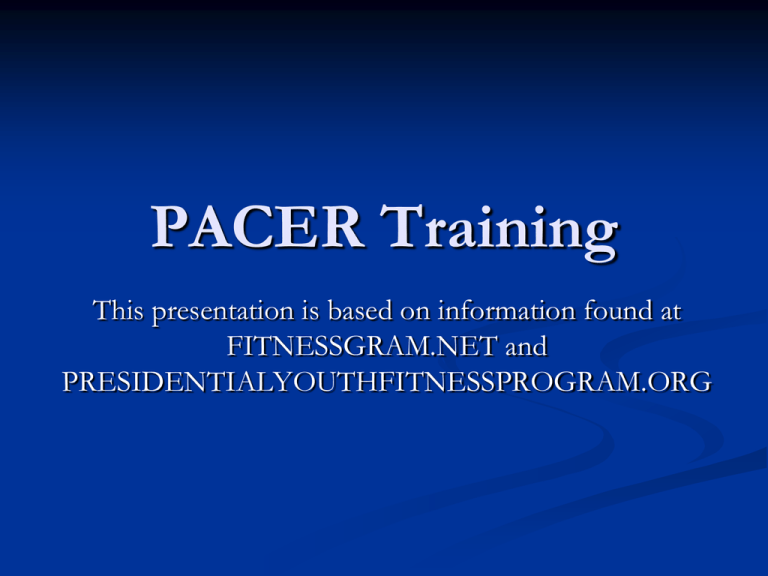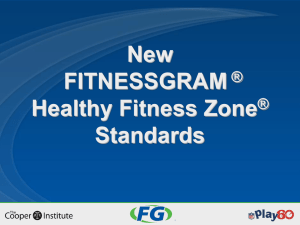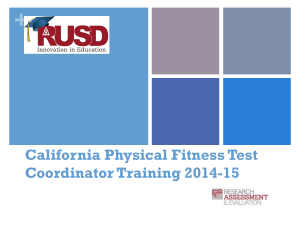PACER Training
advertisement

PACER Training This presentation is based on information found at FITNESSGRAM.NET and PRESIDENTIALYOUTHFITNESSPROGRAM.ORG Outline of Training I. II. III. IV. V. VI. VII. Overview of Aerobic Capacity Testing What is the PACER? Why change from Mile to PACER? PACER Requirements PACER Procedures PACER Guided Practice Wrap-up Overview of Aerobic Capacity Testing Aerobic capacity (AC) is arguably the most important component of fitness. Research reveals that AC is clearly linked to blood pressure, coronary heart disease, obesity, diabetes, and some forms of cancer. AC relative to body weight is the most accurate method of measurement. Here’s how its done in a laboratory situation when researchers need the most accurate results possible and can get direct measurements: Treadmill Test Overview cont. The results from the previous treadmill test are expressed in mL of oxygen per kg of bodyweight per minute. VO2max is a person’s greatest rate of oxygen consumption during exercise. Field tests such as the PACER, mile run, and walk test are used to predict what someone’s VO2max would be in a lab. What is the PACER? PACER stands for Progressive Aerobic Cardiovascular Endurance Run The PACER test is an adaptation of a previously published 20 meter shuttle run test. The PACER starts off easy and progressively gets more difficult. The number of completed laps, the student’s gender, age, height, and weight are used in an equation to estimate VO2max. Here’s a short video of the PACER in action. Please note that there are way to many participants! Why Change from Mile Run to PACER? Students find PACER a more enjoyable alternative to distance running when set to music. Recent research has shown the PACER to be equal to or better at predicting VO2max than the mile run. Reliability is greatly enhanced due to controlled environment. The PACER has a built-in warm-up and typically takes less time for a student to complete. Poor performing students will finish early and not be subjected to embarrassment of being last person to complete a mile run/walk. PACER Requirements 1. 2. 3. 4. 5. 6. Flat, nonslippery surface at least 20 meters long (15 meter PACER is an option if space doesn’t permit 20m testing) CD/mp3 player with adequate volume PACER CD from Fitnessgram Marker cones to establish lanes Pencils and score sheets Tape, chalk, and/or paint for lines PACER Procedures 1. 2. 3. 4. 5. Mark the 20 meter (65’8”) course with marker cones to divide lanes allowing 60 inches for each student and mark the end lines. (15m=49’2”) Make copies of score sheets for each group of students to be tested prior to test day. Allow students two practice sessions before test day. Have students select a partner if you plan to utilize partner scoring. Start the appropriate PACER CD Track. PACER Procedures cont. 6. 7. 8. 9. 10. After the 5 second countdown, the students will start. Each student should run across the 20m distance and touch the line with a foot by the time the beep sounds. At the sound of the beep, he/she should turn around and run back to the other end. Students who arrive early must wait for the beep. Students who don’t reach the line in time must immediately turn and run back to the other end. Students continue until they fail to reach the line before the beep for a second time (or if they don’t attempt the next lap). PACER Procedures cont. 11. 12. 13. 14. Triple beeps serve the same function as regular beeps but also alert students to an increased pace. For scoring purposes, the first “miss” counts but the second does not. For example, a student fails to touch the line in time on lap 15 and maintains the pace until another miss at lap 25. The student’s score would be 24 laps. Allow for an exit procedure. Depending on the teacher’s preference and space, students may either exit the testing area at the endlines or may continue walking in their lanes until all of their cohorts complete the test. This protocol must be followed in order for a valid VO2max to be calculated. Utilizing different distances, allowing students to take a lap “off”, or allowing additional misses will invalidate your results. PACER Resources Here’s a great training video from the Cooper Institute on Youtube. Here’s another great training video posted from the California Department of Education. PACER Guided Practice I. II. III. IV. Set up the course Walk through the protocol Administer the PACER Questions









